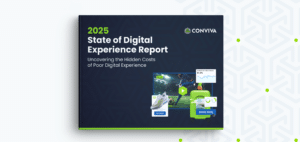Reports
eBook: 5 Strategies to Escape the Observability Money Pit and Boost User Experience

How to Deliver Great User Experience While Reducing Your Observability Costs.
The balancing act: using operational data to drive customer & business outcomes.
As consumers have become increasingly reliant on digital platforms for their everyday activities, they have come to expect those platforms to deliver consistently delightful experiences. Unhappy customers will quickly let companies know there’s a problem with their experience—and not only via customer service calls; they’ll post their dissatisfaction publicly on social media and rapidly move on to other service options. This makes Quality of Experience (QoE) the most critical metric for your long-term success in the digital marketplace, representing the heartbeat of user satisfaction for your application. A consistently seamless and intuitive user experience drives loyalty and ultimately impacts the bottom line for your business.
However, effectively making decisions that drive customer outcomes by correlating all your data is a gargantuan task. Precisely aligning customer satisfaction to system performance means tracking every click, every swipe, every session, every interaction—every second of every day. As you can imagine, the amount of data generated here is truly vast. This creates costs to teams, including noise, alert fatigue, and team confusion during incident response.
On the financial side, existing monitoring and analytics solutions typically charge based on data ingestion and storage, which escalates costs as organizations scale to meet heightened demand. As companies grow and their user bases expand, the volume of data generated by their digital platforms increases proportionally. Consequently, organizations find themselves grappling with burgeoning bills that strain budgets and erode profitability.
To overcome these challenges, Conviva offers a unique approach to operationalizing data in a precise, context-rich manner that drives efficiency and reduces cost. Our approach is anchored in five core strategies, each designed to address specific challenges and empower organizations to deliver exceptional user experiences while minimizing costs:
Ingest
By leveraging advanced sensor modules and workflow tools, Conviva enables organizations to efficiently capture and analyze business-relevant data without incurring excessive expenses.
Activate
Conviva’s semantic mapping and metric building capabilities enable organizations to customize their operations solutions to suit their specific needs, avoiding unnecessary data collection and associated costs. Instead, organizations can build and activate only the events and metrics essential for monitoring and improving user experience.
Monitor
Through trend analysis, dashboards, and automated alerts, Conviva empowers IT and engineering teams to proactively address issues before they impact user experience. Organizations can monitor and act on quality of experience (QoE) metrics in real time.
Automate
The Conviva platform enables automation of detection, root-cause analysis, and corrective action to streamline operations and reduce manual effort. Leveraging AI-powered alerts and notification channels for routine tasks and responses allows organizations to free up valuable resources and enhance operational efficiency.
Ask
By providing advanced analytics tools and interactive workbenches, Conviva enables teams to gain deeper insights into user behavior and system performance, empowering data-driven decision-making and continuous improvement. Conviva encourages organizations to find answers to questions they may not have considered before.
Together, these pillars form the foundation of Conviva’s experience-centric operations framework, enabling organizations to achieve superior user experiences while effectively managing costs.
Existing solutions miss the mark.
Software is built for people to use, meaning that user experience is the very core of our digital tools and services. Moreover, specific software products— apps, features, systems, programs—win the market when users recognize and return to the exceptional experience provided by those products, leading to engagement, retention, and revenue growth. You’d think, therefore, that perfecting QoE monitoring would be the holy grail for observability tools, and that any challenges would have been overcome long ago. Surprisingly, that’s where you’d be mistaken.
Available observability solutions are still largely service-centric, rather than experience-centric. They continue to focus on the golden signals—Latency, Traffic, Errors, Saturation—which are important but don’t actually tell us much about how our apps impact our users and then our business. Moreover, as illustrated in the diagram below, service issues can ultimately be much less costly than the continuous strain on your business caused by poor QoE.
However, when you have a sprawling device ecosystem with 50+ features on web; 15+ screens on mobile; 10+ technologies across frontend, backend, and server-side; plus mobile SDKs and APIs; QoE is constantly at risk, forcing businesses to ask themselves some challenging questions:
- How do we monitor what we need to know?
- What is that monitoring bill going to look like?
- Does monitoring everything actually help us deliver better experiences to our customers?
The answer to these questions and to achievable, sustainable QoE for your digital platform can only be found in Stateful Analytics. This revolutionary approach to operations enables businesses to easily surface patterns and causes, leading to data-driven decisions for improving experience and performance in tandem.
Until now, companies have struggled to optimize QoE consistently and effectively because doing so requires the ability to track and analyze the sequence, timing, and context of user activities and system events—and their interactions with each other. Traditional solutions are linear rather than contextual, meaning that they aren’t built to tell you how events are related to each other so that you can pinpoint root causes and solve user problems in real-time. Conviva changes the game by rethinking the approach to data, technical decisions, and operations with our five strategies for delivering exceptional user interactions in relation to their systems, allowing for more effective troubleshooting, optimization, and strategic planning.
Conviva Strategy 1
Ingest and instrument only data that powers your business.
How much data are you paying for that you don’t use—or that isn’t helpful? Your current observability solution probably promises to take in all data as a way to eliminate blind spots, leaving you with a near infinite number of metrics, traces, and logs. What the tool actually ingests, however, may not quite live up to the promise. Although vendors say they don’t sample data, the fine print still lays out different intervals at which they collect and send trace data, for example. The data is not actually census-level and real-time, even if it’s also not exactly a sample.
Even if your solution is ingesting absolutely all system data, this may be creating more problems than it solves. Data processing and storage is expensive, so your observability bill grows every time your mobile app scales or you spin up a new server. Additionally, even if key data for solving problems is present, your teams must spend precious time cutting through system noise and alerts to locate the exact issue and put it in context for troubleshooting.
To address this challenge, Conviva advocates for a fundamental shift in the observability space—a new approach to ingesting data. Instead of ingesting absolutely everything at enormous cost, or sampling data at the risk of overlooking critical user experience issues, Conviva allows businesses to examine the events that are being collected from their digital platforms and make informed decisions about which events actually matter for their business goals. Anything that doesn’t make the cut simply gets blocked (although an event can always be unblocked, if it becomes important in the future), which controls both data processing costs and the amount of information that teams must examine in order to pinpoint problems. By selecting the events that matter most for user experience, organizations can gain a comprehensive understanding of user interactions in relation to their systems, allowing for more effective troubleshooting, optimization, and strategic planning.
Additionally, control of what events are ingested or blocked and how they are mapped to business metrics is all controlled server-side and then sent over to the config file of the SDK. This creates an agile, flexible, cost-effective operations solution, since the SDK never has to be reinstrumented to accommodate updates to event and metric settings.
However, just because you decide to block certain events doesn’t mean that you sacrifice comprehensive data ingestion. For the events that you decide to prioritize, ingestion of data is census-level, real-time, and internet- scale, meaning you get complete insight down to the individual user level of everything that is happening for users in your platform at every moment.
This new approach to data ingestion ensures that every piece of data aligns with the needs and priorities of both customers and the business as a whole. By collecting and analyzing data that directly impacts user experience, system performance, and business outcomes, organizations lay the foundation for identifying and resolving technical issues in real time, while also uncovering opportunities for product improvement and innovation.
How Conviva achieves this:
Census-Level Data Ingestion
Conviva’s platform leverages census-level data ingestion to capture all
user interactions and events in real-time, without relying on sampling or aggregation. This approach ensures that no data is overlooked, providing organizations with a comprehensive and accurate view of user behavior and application performance.
Lightweight SDK
Conviva’s lightweight SDK offers an efficient method for collecting user data without imposing significant overhead on application performance. By minimizing the impact on app resources, Conviva enables data collection across a wide range of devices and platforms. Organizations can ingest all user data without compromising user experience.
Event Blacklisting
Conviva gives you the flexibility to decide which data matters to your organization, and to pay for that data only. This lets you optimize your resource allocation.
Conviva Strategy 2
Activate and build metrics that matter.
The activation of data is crucial to ensuring that teams can gain actionable insights that align with their goals. However, traditional observability approaches often inundate teams with data, out of the belief that more data leads to a tighter correlation between issues and root causes and faster discovery of the needle in the haystack. Unfortunately, the production environment changes at each deployment, relies on multiple services and languages and CDNs, and involves 3rd-party scripts for frontend and backend. This multiplication of variables means there are dozens of haystacks to search through when it comes to hunting down that elusive needle.
To address this challenge, Conviva advocates for organizations to selectively activate and analyze only the data that truly matters to their teams and business objectives. By adopting this approach, organizations can regain control over their data and tailor their operations efforts to align with specific roles, teams, and business needs. Rather than drowning in a sea of metrics, teams can focus on the key indicators that directly impact customer satisfaction, system performance, and business success.
Conviva’s approach to data activation is characterized by flexibility, simplicity, and efficiency. Through flexible data activation capabilities, organizations can choose to pay only for the data they deem essential for analysis, reducing unnecessary storage costs. Additionally, Conviva’s semantic modeling technology automatically adds meaning to user data, helping to reduce noise and streamline the analysis process. By assigning context and relevance to each data point, semantic modeling enables teams to extract actionable insights more efficiently, without being overwhelmed by raw data.
Furthermore, Conviva offers a custom metrics builder tool that empowers organizations to create business-specific metrics without the need for complex coding or technical expertise. This feature accelerates troubleshooting efforts by enabling teams to define and monitor performance indicators that directly correlate with their unique business objectives and KPIs.
By leveraging these advanced capabilities for data activation, organizations can streamline their observability efforts, improve operational efficiency, and drive better business outcomes.
CONVIVA STRATEGY 3
Monitor experience-impacting issues to reduce false positives & system noise.
Often the most difficult question for product and service providers to answer when dealing with experience and system issues is simply where they should start troubleshooting. Many solutions offer top-10 metric groupings and averages, but these don’t necessarily come with the context needed to make them directly helpful when you have a frustrated customer on a call. Logs and traces usually require teams to have a sense of what they are looking for already or else spend time sifting through mountains of data to get to anything useful. Multiple teams end up being called in to solve one small problem, leading to loss of time, revenue, and resources across the business.
Conviva takes a different approach to incident response by prioritizing the most significant customer problems first and correlating them directly to system performance for speedy resolution. This empowers teams to catch the biggest problems across the user flows that matter to their business:
Conviva’s platform is designed to allow teams to view and communicate with the metrics that matter to their business for streamlined monitoring and optimization. When a specific incident happens, they can also leverage our AI to drill down to the root of the problem in real time.
Advanced AI Correlation
Conviva correlates every user event to trend QoE, highlighting user groups experiencing issues and prioritizing the most significant areas for improvement.
One-Click Customization
Teams can effortlessly customize metrics tailored to their roles, products, and business needs, gaining access to relevant insights in a matter of seconds.
Customer Experience Index (CEI)
Conviva’s CEI provides a clear benchmark for customer experience, aligning teams with industry standards and best practices. This metric provides a north star for customer experience.
With these key capabilities, Conviva empowers teams to monitor what truly matters with confidence, enabling them to drive continuous improvement and deliver exceptional user experiences at scale. Conviva helps deliver features that improve experience and engagement: teams can correlate system performance to customer experience and user drop-off, customize any business-relevant metric in seconds, and pinpoint granular components causing problems.
CONVIVA STRATEGY 4
Automate incident response (by prioritizing customer issues).
In an ideal scenario, organizations achieve alignment between technical and line-of-business teams, fostering shared goals and processes. This alignment enables teams to prioritize customer satisfaction for improved business outcomes, while reducing tool sprawl, team siloes, and monitoring costs.
However, complex cloud-native applications and microservices have introduced a dependency explosion. Teams need to manage trillions of dependencies across devices, networks, apps, and cloud infrastructure. As we have discussed, current monitoring solutions promise to take in all your data and apply AI and machine learning to correlate everything that’s happening and highlight anomalies. The theory is that the more data you feed into the system, the smarter it gets, allowing it to filter out irrelevant system noise and alerts, and leaving teams with the most critical issues.
In reality, product, engineering, and operations teams that use a combination of existing observability solutions frequently encounter silos and data fragmentation. Additionally, the deluge of data from a variety of sources inevitably results in more noise and increased alert fatigue, leading teamsto overlook what really impacts their customers and business goals. Key shortcomings of these tools include:
- High Costs
Ingesting all available data to derive value leads to exorbitant monitoring bills. - Data Redundancy
Teams waste valuable time sifting through redundancies and duplicate data from different tools, hindering efficiency and productivity. - Lengthy Setup and Customization
Traditional solutions often entail lengthy setup and customization processes, requiring significant manual efforts and delaying time to value.
Conviva’s ultra-effective data platform is able to minimize the noise by focusing on customer experience as the chief criteria for prioritization of system issues. Instead of trying to catch and fix everything across trillions of dependencies, our AI is focused on what genuinely matters for businesses: happy users. Conviva’s ECO starts with users as the focal point and aligns alerting and incident response to tackle and resolve the biggest problems impacting the most users.
Since we understand that teams can hardly spend all their time monitoring metrics—even the most important ones—our AI Alerts are automated to notify them if any experience metric undergoes a deviation that indicates an obstacle in the user journey. Once alerted, they can view that metric within the Conviva dashboard and drill down into all associated dimensions and traces to pinpoint the exact backend or 3rd-party root problem. The dashboard will also display the cumulative user impact of any issue so that your teams can see how problems are developing in real time and prioritize the most critical ones accordingly. This enables you to mobilize your teams efficiently, reducing costs and improving the overall user experience.
Conviva Strategy 5
Analyze for long-term product optimization.
One of the most critical concerns for digital businesses is how to continuously optimize their platform and improve QoE for users. Of course, the ability to triage and solve issues in the moment to prevent churn is important, but even if you can effectively troubleshoot your platform on a day-to-day basis, an inability to improve and future-proof it in ways that make sense for your customers will eventually cost you.
So how do you strategically improve your platform across web and mobile? You need the ability to implement the features and functions most attractive to users, while also aligning teams around the priorities involved in maintaining and optimizing your services. Standard observability solutions have come a long way in this area. Most now offer client-side benchmarking, Digital Experience Monitoring, core web vitals, aggregates and percentiles, and session replay. Many solutions also allow you to customize their toolset to help pinpoint the insights you need, but that requires significant engineering time and reconfiguration.
Moreover, trouble still lingers because multiple teams share customer experience but often nobody owns it.
Web marketing, IT, engineering, product, mobile engineering, and sometimes performance teams can readily become misaligned on business metrics and benchmarks, with different teams relying on different tools and prioritizing different aspects of system performance. This leads to faulty assumptions about what good customer experience is.

Page load times aren’t reliable benchmarks for dynamic modern pages.

90th percentiles and aggregates don’t help you prioritize improvements that move your business forward.

Synthetic monitoring doesn’t cover real life scenarios
At Conviva, we believe that businesses need to be able to align around unified data sets that represent a single source of truth for super-detailed customer data. Asking informed, strategic questions is part of driving continuous improvement. With advanced analytics tools and interactive workbenches, Conviva provides the means for teams to explore and discover patterns, trends, and anomalies within their user behavior and system performance data. By leveraging these capabilities, organizations can make data-driven decisions around optimizing their offerings. Whether identifying emerging user trends, or uncovering potential issues before they escalate, Conviva empowers teams to harness the full potential of their data.
Previously, business teams each focused on specific components of the system relevant to them. With Conviva, they can instead learn to frame discussions around the customer’s point of view. This creates alignment across businesses, allowing quick and effective prioritization of incident response, debugging, and engineering time and resources. With access to comprehensive and unified data sets focused on exceptional QoE, teams can also conduct in-depth analyses, test hypotheses, and iterate on their strategies to drive platform improvements, growth and retention strategies, and increased revenue.
Connected data sets focus on customer and business value
The transformative power of an Operational Data Platform.
After seeing the limitations of traditional monitoring and analytics solutions, you can’t afford to go back to that status quo. By focusing on the data that directly impacts user experience and business outcomes, organizations can reduce unnecessary data storage and processing costs, ultimately leading to cost savings.
By prioritizing quality of experience and aligning technical decisions with business outcomes, organizations can put their data to work for their biggest business needs:
Troubleshooting the biggest customer issues during incident response.
Every second counts when it comes to resolving customer issues. That’s why it’s critical to take a customer-first approach to your data. By starting with your customers’ experience and linking it to system performance, your teams are equipped to identify and address the biggest customer issues with speed and precision. Whether it’s a performance bottleneck, a user experience glitch, or a service outage, Conviva’s ECO approach enables root- cause diagnosis so that the right solutions can be implemented, minimizing downtime and maximizing customer satisfaction.
Prioritizing the biggest improvements for your digital experiences.
Customer expectations are constantly evolving, and staying ahead of the curve is essential to maintaining a competitive edge and meeting business goals. However, to satisfy users you have to measure what really matters to them. Only Conviva can deliver the deep contextual experience metrics that help you bring that to life. Whether it’s enhancing usability or refining feature sets, an organization can use ECO to ensure that resources are allocated strategically to deliver the greatest impact where it matters most.
Driving team efficiency while focusing on what matters most.
In a complex and interconnected digital ecosystem, effective collaboration and alignment are necessary for success, and the best means for uniting technical and non-technical teams is a focus on quality of experience. With the unified, comprehensive view of user data and access to key QoE insights and metrics built into Conviva’s ECO approach, teams can break down silos and get on the same page, driving alignment and efficiency. From development and operations to marketing and customer support, everyone is empowered to work toward common goals and deliver exceptional experiences.
Success Story
COMPANY STORY
Elite performance in live sports
In the competitive world of live sports streaming, a flawless viewer experience is the baseline. And just six months after debuting their platform, one new service provider streamed 64 top-tier sporting events without a single disruption or complaint. Here’s how they tackled this challenge with Conviva’s help.
CHALLENGE
Building excellence from scratch
Launching a new streaming service meant starting from ground zero in terms of analytics. This posed a significant challenge, requiring a robust solution that would be able to scale—and quickly—for the spikes in viewership during major sports events. Immediate insights were necessary to address changes in real time and ensure uninterrupted viewing experiences. Minimizing disruptions during game times was a top priority, or they risked alienating their growing viewer base.
SOLUTION
Scoring big wins with Experience-Centric Operations.
The streaming service turned to Conviva. Conviva’s Real-Time Trends Dashboard became the linchpin of their strategy, enabling them to detect, diagnose, and resolve quality issues in real time, even during high-profile sports matches. Conviva’s AI-powered alerting system automatically identified quality errors affecting subsets of viewers across devices, ensuring a consistently high-quality stream for all.
OUTCOME
Winning streaming experiences
With Conviva’s suite of tools, the streaming service overcame significant technical challenges and delivered flawless streaming experiences, even under high-pressure conditions. This success underscores the power of Conviva’s solutions, demonstrating how they enable even newcomers to deliver high- quality streams at scale.




